PAPPAGALLETTO OF LESSON
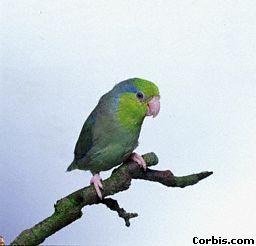
Italian: pappagalleto of Lesson
English: Pacific Parrotlet
German: Blaugenick-Sperlingspapagei
Between the representatives of the sort Forpus, without doubt, the devout ones represented in the Italian breedings the coelestis; original of the Atlantic coasts of the South America between all forpus devout sturdy and the adaptable one to what it is reproduced with greater facilit.
The male characterized from the sopracciglio, the codione and the remiganti color blue cobalt with shadings viola mkentre the female normally all green, but some exemplary of the subspecies "polish" have the blue codione and I point out of sopracciglio; in these subjects the only sign of reliable dimorfismo that one of the remiganti that only the male has blue
Length : 13 centimeters
Distribution: the north-west of For, western Ecuador.
Habitat : dry tropical zones and in particular savana cespugliosa, campaign and deciduous wooded land.
Natural diet : seeds, berries and fruits of cactus.
Breeding in nature: the period of breeding begins after the season of rains, from January until the May end; practically all the holes available are use you like nests, holes in the cactus, coppers, the trees, the poles of the telephone, installations on the giacimenti of oil, estremit opened of the tubes, also the old nests of the other birds.
Feeding: mixture of seeds for small parakeets with least small sunflower and much scagliola; it yields and verdure (carrot, pear, apple, maize, etc.); pastoncino proteico for the breeding of piccoli.Personalmente I put to disposition of the riproduttori a animal food made in added seed house bubbled and frutta.Osso of small cuttlefish (or notebooks of know them mineral), grit and fresh water always to disposition.
Breeding in cattivit: By now very it stabilizes to you in cattivit, birds been born in breeding reproduce also in little spaziosi containers type cages from broods of 50 x 40 x 40. Waves to avoid that the subjects fatten too much, it would have, for, to lodge them in cages at least 70x 40x40, or to arrange them in volierette, to outside of the riproduttivo period.
They are tendentially timid parakeets towards the man but, with the time, they can succeed in to become confidenti and they turn out much sturdy and resistant to the diseases.
Above all in the period of the reproduction, they can become much aggressive in the comparisons of the congeneri but they have the necessit of being in company in order to avoid conditions of stresses that can carry also the dead women.
They resist to minimal temperatures of 10C, but sopportano also inferior temperatures to the zero, if they have the possibilit to shelter itself in a nest very coibentato.
The main reproduction begins in spring but, if it lodges to you in atmospheres heats to you and very it illuminates in order at least 14 hours the day to you, they reproduce all the year.
They place from 4 to 10 eggs, usually 6 to intervals between 24 and 48 hours and begin to incubate from according to egg.
Incubation 21 - 24 days; the small are nourished in the nest, from the female imbeccata from the male, for four - six weeks and the young people that exit from the nest are normally independent after one week - ten days from the involo.
To this point, advisable to separate them from the parents who, otherwise, can perseguitarli and to bite them until killing them in order to begin one new brooded. Attention above all to the young males who, outside from the nest, come little gladly accepted from the father.
The young people are mature sexually around to the 10 months a year, ET to which they begin to riprodursi regularly (the males some time are fecund gi to four months) but, normally, they only become good breeders to according to life year.
Nest:

In reproduced figure auna cassette nest that personally I use. The "L" turned upside down for fundamental experience in order to avoid that the preciopitandosi males to the inside of the nest piombino on the female in broods or worse on uova.Le the dimensions of the nest they are to the center of various currents of thought; some breeders prefer nests of smallest dimensions (until 10x10 of base) and others use nests until 20x20 of base.
First they support that the forpus they gladly adopt devout nests of small dimensions, the others, of which I I make part, use generous dimensions devout in order to avoid overcrowding, in case of brooded numerous (much frequent).
The only found disadvantage the possibilit, above all in young and inexpert subjects, of dispersion of eggs with difficolt of broods.
Many mutations of color of the forpus exist coelestis; all the found mutations are recessive and nobody sex-tied. It is believed that the coelestis they follow the model of mutation of the parakeets from the collar.
BLUE MUTATION
 The fascinating blue mutation probably devout and the spectacular one. The blue coloration differs between subjects and goes from a soft blue until the blue sky. In the males the blue of the remiganti and the sopracciglia assume colors intense cobalt. This mutation has a personalit particularly sweet is like domestic animal is with the others forpus.
The fascinating blue mutation probably devout and the spectacular one. The blue coloration differs between subjects and goes from a soft blue until the blue sky. In the males the blue of the remiganti and the sopracciglia assume colors intense cobalt. This mutation has a personalit particularly sweet is like domestic animal is with the others forpus.
MUTATION LUTINO
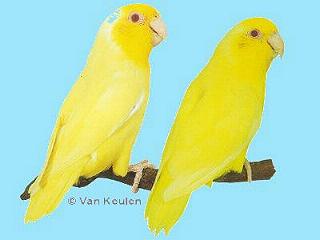 The Lutino mutation to times confused with the yellow color American but the subjects lutino is only colors to you of yellow and the blue in the males replaced from the white man and moreover has the red eyes.
The Lutino mutation to times confused with the yellow color American but the subjects lutino is only colors to you of yellow and the blue in the males replaced from the white man and moreover has the red eyes.
YELLOW MUTATION AMERICAN
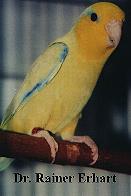 The yellow mutation American mutations in which the copy it replaces the green with a yellow luminous lemon maintaining the blue marcature unchanged and be discovered negli Be United dal Dr.. Rainer Erhart.
The yellow mutation American mutations in which the copy it replaces the green with a yellow luminous lemon maintaining the blue marcature unchanged and be discovered negli Be United dal Dr.. Rainer Erhart.
MUTATION PASTEL Or EUROPEAN YELLOW
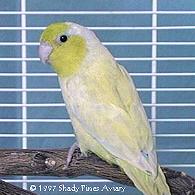 To times it comes confused with the yellow American in how much some subjects so are diluted to have to only read soffusioni of green but they are much devout common in Europe of the conspecifico of beyond the ocean and with the exception of this last several green piumaggio to dilution degrees.
To times it comes confused with the yellow American in how much some subjects so are diluted to have to only read soffusioni of green but they are much devout common in Europe of the conspecifico of beyond the ocean and with the exception of this last several green piumaggio to dilution degrees.
MUTATION FALLOW
 In this mutation the green comes clearly replaced from a green yellow and the beige. The eyes are red darkness and the blue of the males assumes tonalit diluted.
In this mutation the green comes clearly replaced from a green yellow and the beige. The eyes are red darkness and the blue of the males assumes tonalit diluted.
MUTATION ISABELLA
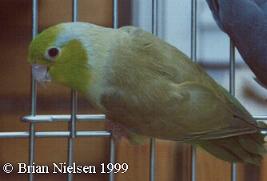 The mutation isabella one of first appeared in Europe but not common how much probably spectacular devout others.
The mutation isabella one of first appeared in Europe but not common how much probably spectacular devout others.
GREEN MUTATION OLIVE
Forpus coelestis the green olive is subject in which the green deep olive has assumed a green tone while the blue maintains its tonalit. They are premonitory of the mutation the cobalt.
MUTATION PEZZATA
They are subject in which the piumaggio it has lost melanina producing wide yellow zones. Probably they have had to the yellow connection American with ancestral subjects.
The subjects of forpus coelestis to "double factor" are birds that demand two geniuses of mutation color in order to produce the color.
MUTATION ALBINO
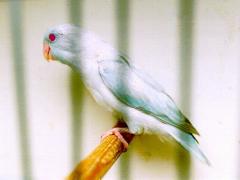 And the combination of the blue mutation and that lutina. The turning out subjects are completely white men with the red eyes and the males and the females are perfectly equal and must be sessati for surgical way or DNA.
And the combination of the blue mutation and that lutina. The turning out subjects are completely white men with the red eyes and the males and the females are perfectly equal and must be sessati for surgical way or DNA.
MUTATION WHITE MAN AMERICAN
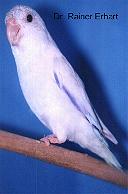 This extremely rare mutation in truly spectacular Europe. The green replaced from the white man but in the male the blue remains unchanged. The black eye.
This extremely rare mutation in truly spectacular Europe. The green replaced from the white man but in the male the blue remains unchanged. The black eye.
E' given from the combination of the blue with the yellow American.
BLUE MUTATION PASTEL
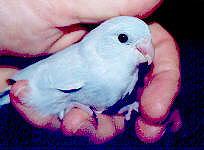 Also this mutation, combination of the blue and the pastel, truly magnificent. The changed subjects are color you of blue sky pale and have the black eyes.
Also this mutation, combination of the blue and the pastel, truly magnificent. The changed subjects are color you of blue sky pale and have the black eyes.
MUTATION BLU-FALLOW
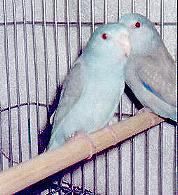 They are given from the combination of the blue with the fallow. These birds blue-clearly have luminous red eyes and maintain their blue marcature on the males and on the females of it polishes.
They are given from the combination of the blue with the fallow. These birds blue-clearly have luminous red eyes and maintain their blue marcature on the males and on the females of it polishes.
MUTATION COBALT
The cobalt a combination of the blue factors and green olive that produces a deep dark blue bird with the marcature viola on the wings and the codione of the males. Extremely rare and expensive E'.
In we are attended of the mutation viola given from the combination of cobalt with the dark green.
SUGGESTED BREEDINGS by MENANDPETS.COM
No breeding to signal
if you want to know like signaling yours, contacts: marketing@inseparabile.it
GREY MUTATION
This splendid little known mutation and little is known of its origins.
MUTATION To YELLOW HEAD
Currently in course a debate if this one mutation or one subspecies previously disowned. In this bird, the forehead, the cheeks and the mento are yellow anzich green-gray. Up to now, only the males have visualized the characteristic.
we thank the breeding agate in order to have to us supplied this card